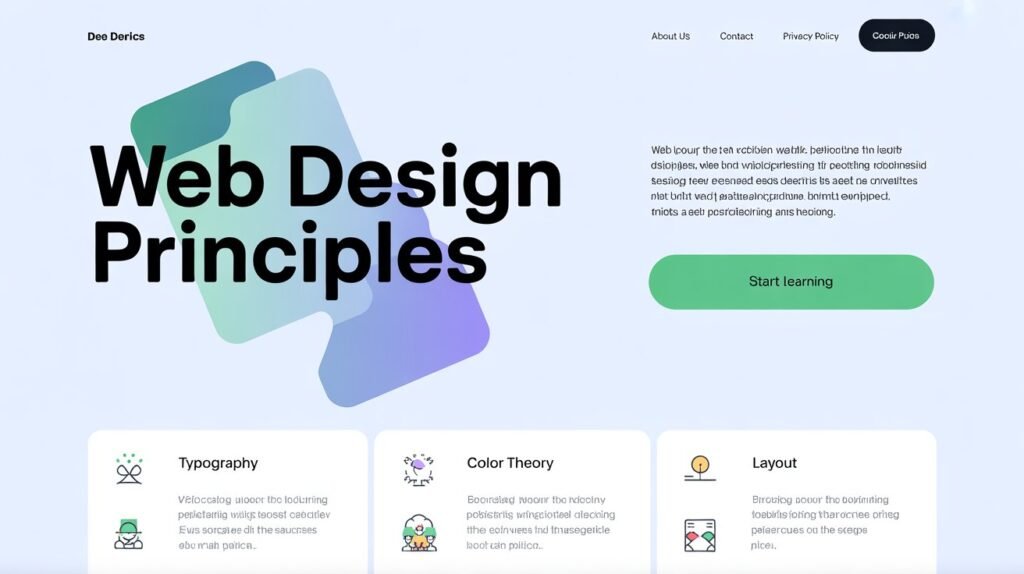
For a beginner in web design, the web design principals will mean the difference between creating simple pretty websites and creating working ones. Most people will find that the website serves as the first contact to a business or an idea, and if it feels messy or confusing, there are many that will leave fast.
This is enough understanding of web design principles for beginners to entice and keep a user. This guide illustrates how to design with the user in mind, develop a simple layout, choose the most effective colors, and develop fast, responsive, and accessible sites.
Understanding the Basics of User-Centered Design

Good designs always begin with the user. You do not design a site for yourself; the design must contemplate in the first instance what the users want, how they fetch information, and minute expectations for receiving those results.
User-centered design provides a natural, easy feel with the website. For example, the online store must have product pages that are very clear, a checkout process that goes without a hitch, and support options that are readily visible throughout the site. A blog should offer readable text, ease of navigation, and related posts.
Learn More : How to apply web design principles
Layout and Structure: Building the Foundation

contribution to the overall architecture of a house, so does layout; without a layout everything goes haywire. A good layout organizes content to be able to scan and comprehend fast by visitors. People do not read everything on a page; they scan it. This is why it should use sections, headings, and white space.
One of the most common layout systems is the grid system. It keeps design balanced and aligned. A clear structure would also include placing the most vital elements such as menus, logos, and calls to action where the user expects them to be. If users do not find what they are looking for within seconds, they leave the website.
Common Layout Patterns in Web Design
| Layout Pattern | Best Use Case | Example |
| F-Pattern | Text-heavy sites | News sites, blogs |
| Z-Pattern | Simple landing pages | Startups, product sites |
| Grid Layout | Balanced visuals | Portfolios, stores |
Visual Design: Color, Contrast, and Typography
While colors and fonts create the first impression of any site, bright colors capture attention while muted tones give that calm feeling. By selecting the right palette, emotional bonding can be achieved. For example, blue is often used in life sites as it connotes trust.
Typography is important too. The wrong font can make the viewer’s experience a nightmare. Ensure text is at the right size, wide enough line spacing, and strong enough contrast text for readers to easily read it. A good rule is dark text on a white background. Strong Visual Design has made the site attractive and functional too.
Navigation and User Flow
Everything about site navigation is like a site map. If users can’t find what they need, they won’t be sticking around. Great navigation makes simple menus and easy-to-understand links – basically, walking the visitors through the process step by step until they reach their desired goal.
User flow means the path someone takes on your site. The user flow through an online shop might go: homepage → product page → add to cart → checkout. If any of those steps become too long or confusing, that can create drop-off points. Navigation that works will keep people satisfied, not frustrated.
Mobile-First and Responsive Design
The majority of today’s users visit sites on their phones. Because of this, mobile-first design must be prioritized. A mobile-first site starts with small screens in mind and works its way up to larger screens, ensuring that the design works across all devices.
Responsive design comprises flexible layouts and images that adapt in an automatic manner. You don’t want text to be cut off or buttons to be too small to tap. Google rewards mobile-friendly sites with better ranking, so mobile-first is not just design best practice-it’s also a smart SEO strategy.
Loading Speed and Performance
If a website is slow, it is dead. Users generally leave if a web page takes longer than 3 seconds to load. Speed is an important rule of thumb regarding web design for the beginner. It greatly influences experience and search engine rankings.
To speed things up, optimize image sizes, minimize script usage, and ensure caching is enabled. Tweaks here and there make all the difference. A trustworthy and fast site will frustrate visitors seeking to get things done quickly. Performance, the hidden engine, keeps your website alive.
Website Speed and User Behavior
| Load Time | Bounce Rate | User Behavior |
| 1-2 sec | Low | Engaged |
| 3-5 sec | Medium | Impatient |
| 6+ sec | High | Leaves site |
Accessibility and Inclusive Design
Accessibility simply means aiming for a website that is accessible to everyone-including people with disabilities-so it cannot be optional. Excluding users is not only unfair; it loses visitors. Alleviating users from the pains of using the site will include adding alt text, showing strong contrasts, and allowing navigation using keyboards.
To the extent that flow and language could be major cultural differences, inclusive design has a layout for it. Use time formats that read 12 months and do things millions can do with right to left for the global audience.
Content and Visual Balance
It goes beyond the visual design, however: content is equally important. A website without proper content is like an empty book With no text in it. Balance is achieved through supporting text by images competing against each other.By making things wordy, visitors get swamped, inundated by roaming images.
Balanced with the appropriate mixing gives flow. An example would be making use of pictures for evoking meaning, relevance, to illustrate. Breaks down content with heads so as to give readers an idea where they are; and do not feel lost. Balance makes your site beautiful and functional.
Trust Signals and Professional Touches
In such cases, looks do not always suffice. Users must feel safe navigating the site. Trust signals such as SSL certificates for security, views by customers, and visible contact details lend to credibility. Without trust, no one will buy or divulge their personal details.
Professional elements do matter: Branding should be consistent; logos should be clear; image quality should be high since these instill an impression of care. Relatively small faults such as broken links or easy spelling errors can also diminish trust.
Common Trust Signals in Web Design
| Trust Signal | Why It Matters | Example |
| SSL/HTTPS | Data protection | Secure checkout |
| Reviews | Social proof | Product ratings |
| Contact info | Reliability | Address, phone |
| About page | Human touch | Company story |
Testing, Feedback, and Iteration
No web development becomes perfect during the first instance. Testing tells one what works and what does not. The analytics tools report where the users click, how long they stay, and where they leave. These insights are then acted upon to improve the design.
Feedback also bears weight. Asking the users directly what they like or dislike can save time. Through iteration, we mean going through the cycle of design, testing, and improvement once again. This cycle keeps the website modern and efficient. Web design is not a one-time task; rather, it is a continuous journey.
Consistency Across Pages
Consistency happens to be the most precious neglected web designing principles of a beginner. When one’s website reflects similarity in the feel on every page, a greater sense of trust is likely to be ushered in by the user, for example, when a navigation menu is found shifting from one position to another without relevant change, or a color scheme shifts from one page to another.
Imagine reading a book that every chapter had a different font, a different style of cover, and no numbering system, that would definitely make a reader feel lost. It occurs faintly in the same way in today’s virtual world. Steady layouts, clear typographics, and repeat uses of the color blue used in the branding of a company create harmony in the user’s mind.
Call-to-Action Placement
A call-to-action (CTA) is your next step for visitors. It can be “Buy Now,” “Sign Up,” or “Learn More.” For novices, the placement of CTAs is one of the most important factors. A strong CTA would be placed at a contrasting position with short wording and clear intent. It would be noticeable to visitors without searching for it, but not overwhelming with design.
For example, on an online store, the “Add to Cart” button would be huge, visible, and right next to the details about the product. On a blog, it is best to find a “Subscribe” button at the bottom of a post. Sometimes beginners confuse putting too few call-to-action buttons or hiding them in menus.
SEO-Friendly Design
A new web designer must also take note of the fact that web design is synonymous with search engines. An SEO-friendly website should be easy to crawl and index for ranking. This means the use of clean coding, descriptive titles, and providing alt text in images. This means a site can be user-friendly and technically well-optimized: Site Speed.
Mobile-Friendly, Sensible Headings: Google Judges Speed, Mobile-Friendliness, and Headings. Even things like typography and readable text, clear URLs, etc. may fit into the category of design. To a beginner, one thing should go with the other that is SEO-tagged in relevant documents and not alien to it.
FAQs
What are the most important web design principles for beginners?
The key principles are white space, user-centered design, color, navigation, speed, and accessibility.
Why is mobile-first design important for beginners?
User-centered design, in terms of principles, plays a crucial role when users interact with a computer or any electronic interface they interact with.
How does loading speed affect website success?
Slow speed repels visitors and demotes search ranking, whereas speedy sites build trust and engagement.
What role does typography play in web design principles for beginners?
Typography impacts readability and user comfort. Proper font and contrast enhance the experience.
How can beginners test their website design?
They can utilize analytics tools, perform A/B tests, and gather user feedback in order to enhance the design incrementally.
Conclusion
Web design basics for beginners provide you with the skills to create websites that are easy to use, fast, and accessible. From colors and layout to navigation and speed, every aspect counts. A successful website is visually and content balanced, inspires trust, and makes everyone a part of it. When you design for users and continuously test and refine, you produce websites that stand the test of time. Adhering to these principles is the wisest way to create websites that are loved and repeated by people.



